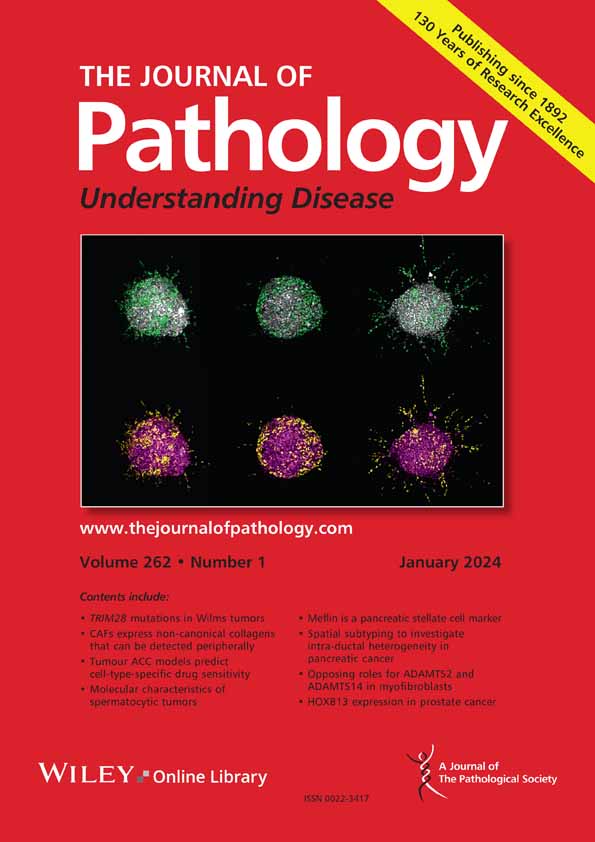Leon J Wils, Jos B Poell, Arjen Brink, Laura AN Peferoen, Ilkay Evren, Elisabeth R Brouns, Jan GAM de Visscher, Erik H van der Meij, Elisabeth Bloemena, Ruud H Brakenhoff
下载PDF
{"title":"New insights into the genetic progression of cancer through longitudinal analysis of oral lesions","authors":"Leon J Wils, Jos B Poell, Arjen Brink, Laura AN Peferoen, Ilkay Evren, Elisabeth R Brouns, Jan GAM de Visscher, Erik H van der Meij, Elisabeth Bloemena, Ruud H Brakenhoff","doi":"10.1002/path.6449","DOIUrl":null,"url":null,"abstract":"<p>Genetic progression models of cancer continue to determine the roadmap of carcinogenesis, although the sequence of genetic events is inferred rather than empirically determined through longitudinal analyses. Here, we present a unique longitudinal study of oral leukoplakia lesions that transformed into carcinoma. Lesions were followed from initial diagnosis through to malignant transformation. For each lesion, biopsies at baseline, the carcinoma, and all available intermediate biopsies were studied for the presence of dysplasia, genomic copy number aberrations, and mutations in selected head and neck cancer genes. Using this information, the phylogenetic history of all carcinomas was reconstructed within the context of applied interventions. In total, 71 biopsies of 21 lesions were studied. The median time to malignant transformation was 60 months. Oral carcinogenesis emerged as a multi-(sub)clonal process. Treatment interventions appeared to impact clonal selection, although lesions always remained after excision. Notably, the lesions demonstrated different routes of progression. A canonical pattern of progression was observed, characterized by longitudinal accumulation of abnormal morphology and genetic changes. However, some lesions followed an alternative, stable pattern of oncogenic progression, with no apparent increase in morphological changes or accumulation of genetic aberrations. This latter pattern appeared to be associated with the development of previously identified ‘copy number quiet’ head and neck tumors. This study provides a novel perspective on the temporal evolution of oral leukoplakia and the different routes to cancer progression and highlights the key role of multiclonal field cancerization in lesion recurrence and cancer development. © 2025 The Author(s). <i>The Journal of Pathology</i> published by John Wiley & Sons Ltd on behalf of The Pathological Society of Great Britain and Ireland.</p>","PeriodicalId":232,"journal":{"name":"The Journal of Pathology","volume":"267 2","pages":"155-167"},"PeriodicalIF":5.2000,"publicationDate":"2025-07-29","publicationTypes":"Journal Article","fieldsOfStudy":null,"isOpenAccess":false,"openAccessPdf":"https://www.ncbi.nlm.nih.gov/pmc/articles/PMC12438000/pdf/","citationCount":"0","resultStr":null,"platform":"Semanticscholar","paperid":null,"PeriodicalName":"The Journal of Pathology","FirstCategoryId":"3","ListUrlMain":"https://pathsocjournals.onlinelibrary.wiley.com/doi/10.1002/path.6449","RegionNum":2,"RegionCategory":"医学","ArticlePicture":[],"TitleCN":null,"AbstractTextCN":null,"PMCID":null,"EPubDate":"","PubModel":"","JCR":"Q1","JCRName":"ONCOLOGY","Score":null,"Total":0}
引用次数: 0
引用
批量引用
Abstract
Genetic progression models of cancer continue to determine the roadmap of carcinogenesis, although the sequence of genetic events is inferred rather than empirically determined through longitudinal analyses. Here, we present a unique longitudinal study of oral leukoplakia lesions that transformed into carcinoma. Lesions were followed from initial diagnosis through to malignant transformation. For each lesion, biopsies at baseline, the carcinoma, and all available intermediate biopsies were studied for the presence of dysplasia, genomic copy number aberrations, and mutations in selected head and neck cancer genes. Using this information, the phylogenetic history of all carcinomas was reconstructed within the context of applied interventions. In total, 71 biopsies of 21 lesions were studied. The median time to malignant transformation was 60 months. Oral carcinogenesis emerged as a multi-(sub)clonal process. Treatment interventions appeared to impact clonal selection, although lesions always remained after excision. Notably, the lesions demonstrated different routes of progression. A canonical pattern of progression was observed, characterized by longitudinal accumulation of abnormal morphology and genetic changes. However, some lesions followed an alternative, stable pattern of oncogenic progression, with no apparent increase in morphological changes or accumulation of genetic aberrations. This latter pattern appeared to be associated with the development of previously identified ‘copy number quiet’ head and neck tumors. This study provides a novel perspective on the temporal evolution of oral leukoplakia and the different routes to cancer progression and highlights the key role of multiclonal field cancerization in lesion recurrence and cancer development. © 2025 The Author(s). The Journal of Pathology published by John Wiley & Sons Ltd on behalf of The Pathological Society of Great Britain and Ireland.





 求助内容:
求助内容: 应助结果提醒方式:
应助结果提醒方式:


